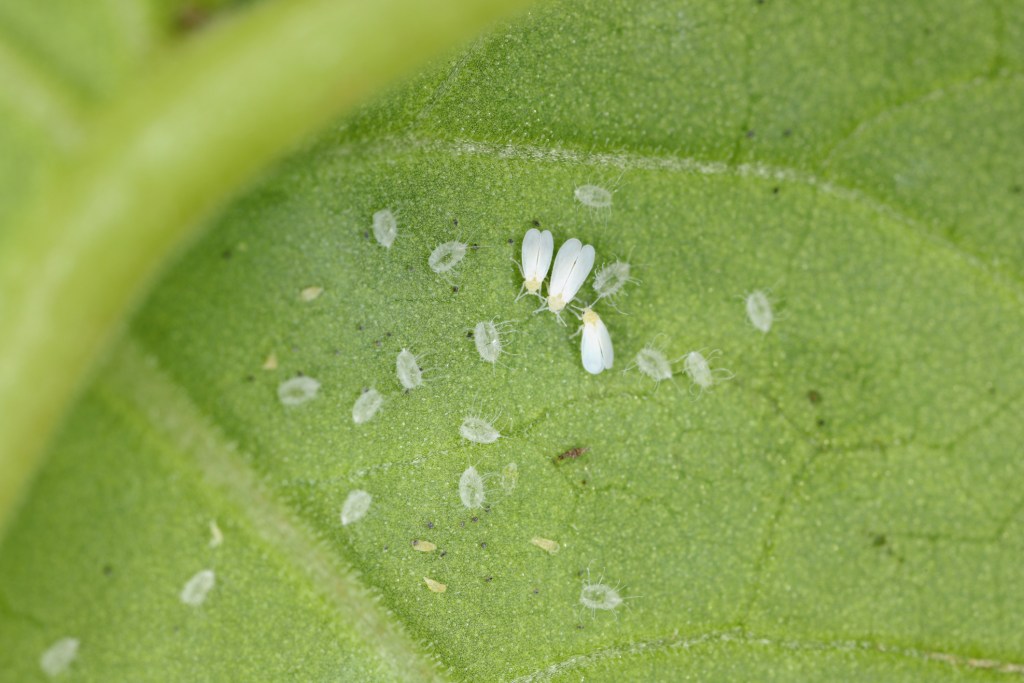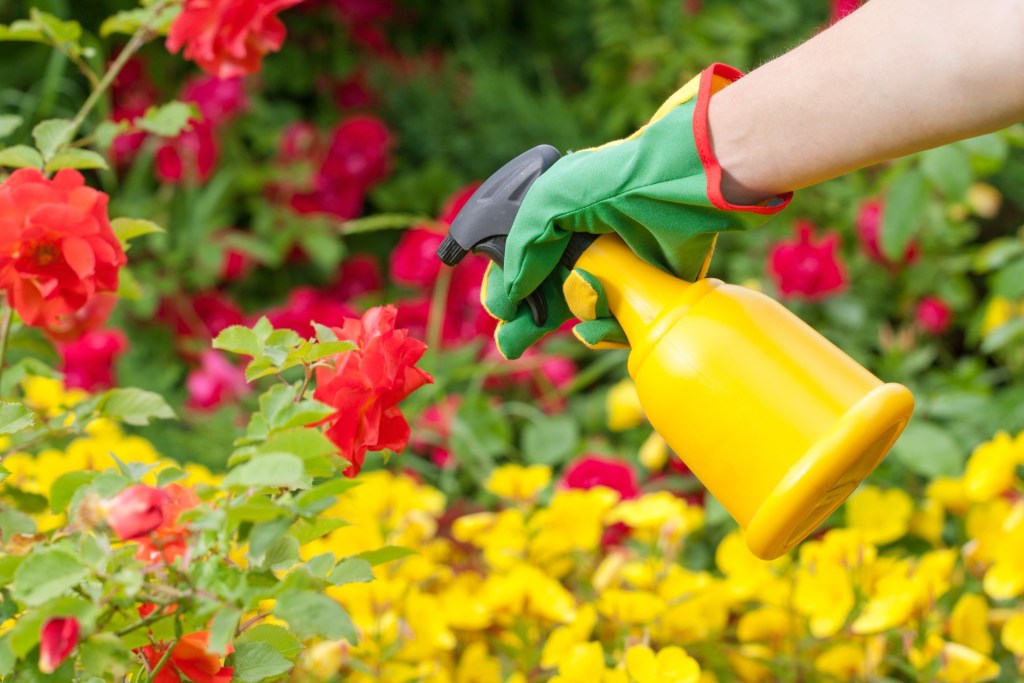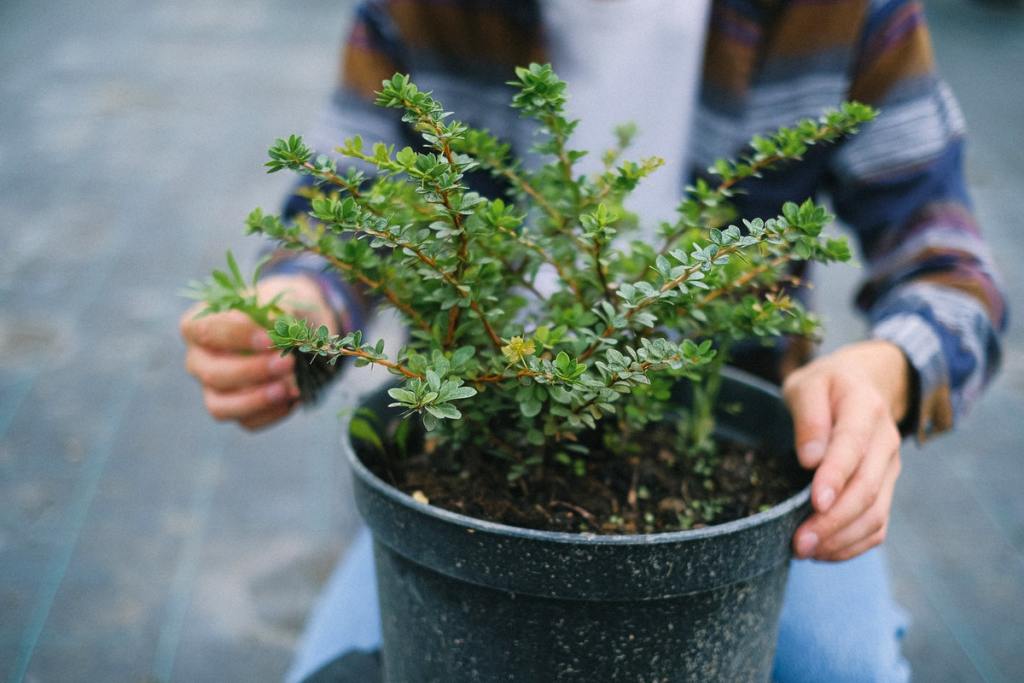Picture this: You’re in your spring or summer garden enjoying the warm air and blue skies when you notice minuscule white creatures flying from the undersides of your favorite herb plant. Those unfortunate enough to witness these soaring pests may be in the presence of a menacing whitefly infestation.
Though mostly harmless, whiteflies can be the bane of your existence if you fail to keep their population in check. Here’s what you need to know about these unseemly, quick-multiplying garden pests and how to get rid of whiteflies effectively.

What are whiteflies?
Winged and white in color, whiteflies are tiny (around 1/16 inches long) soft-bodied pests that suck on plant sap and spread diseases. Calling them “flies” is a bit of a misnomer, since they’re actually more closely related to mealybugs and aphids. When it comes to the type of environment they prefer, they typically enjoy warm spaces. Though common garden menaces, they’re also known to hang around greenhouses and indoor plant rooms.
They reproduce quickly, as an adult whitefly can lay anywhere between 200 and 400 eggs, usually on the undersides of plant leaves, such as basil. Whitefly-infested plants may have white clouds of the pests flying around them, and you might notice sticky “honeydew” on the leaves, which whiteflies secrete as they feed on foliage. Heavy infestations can destroy plant foliage, but whiteflies are often more annoying than destructive.

What is the best treatment for whiteflies?
Although they can be irritating, whiteflies are relatively easy to manage. More often than not, you won’t need to use special chemicals to remove them from your garden. If you’re wondering how to effectively handle an infestation, here are the best treatments to try in your garden.
Spray your plants with water
Sometimes the easiest treatments can be the most effective ones. If you don’t want to go out of your way to get any special tools or solutions, you can simply use a garden hose to spray down your plants. But even if you’re just using water, do a thorough job getting all the flies, eggs, and larvae off your leaves. For dense infestations, it may be best to cut off impacted leaves. Check your infested plants weekly and repeat a good hosing as needed.
Get out your handheld vacuum cleaner
As long as you don’t suck up in any leaves, the vacuum cleaner method can be surprisingly effective. It really is as straightforward as you think — all you have to do is vacuum up larvae and eggs on infested plants. Just make sure to bag up the vacuumed pests into a plastic bag before you throw them in the trash — if you dump them in the garbage without sealing them off, they may find a way to invade your plants again.
Invest in yellow sticky traps
Yellow sticky traps are great for getting rid of unwieldy fungus gnats, and they’re just as effective for diminishing whitefly populations. Acquire a pack of yellow sticky traps from your local nursery store and stick them on impacted areas. The yellow color attracts the whiteflies and they land on the traps, inevitably sticking to them. Once trapped, they won’t be able to reproduce anymore, so your unseemly whitefly population will start to drop in numbers.
Purchase insecticidal soap or horticultural oil
If you’re suffering from a heavy infestation, you might need to invest in an insecticidal soap or horticultural oil. The soap or oil makes it harder for the whiteflies to breathe, so they suffocate to death. Apply your soap or oil as frequently as instructed on your bottle. You can also create your own treatment by mixing a tablespoon of neem oil and a few drops of liquid soap with a gallon of water — spray this onto your plants every week until you don’t see any more whiteflies.

How do I keep whiteflies off my plants?
Check your plants before you buy them
Whiteflies multiply quickly, so they can spread from plant to plant in your space. Before buying a plant, thoroughly check the leaves (including the undersides) and soil for signs of whiteflies. If you suspect you have pests on your new plant, treat it accordingly and quarantine it for a week or two before bringing it into your plant collection.
Add earthworm castings to your soil
It may surprise you to learn that a simple soil ingredient like earthworm castings can ward off those pesky whiteflies. When earthworm castings decompose, they repel whiteflies while fertilizing your plants, so it’s a win-win situation.
Bring in companion plants that repel whiteflies
Plants, such as chives and marigolds, repel whiteflies. Before placing plants next to each other, look up if they’re compatible in the same space — the wrong plants may actually compete with your crops and draw in similar pests.
Spray your plants with a neem oil solution
Every so often, you can use a gentle neem oil solution to spray all over your plants. This keeps whiteflies from laying eggs and feeding on your leaves. Make sure you’re not using neem oil in warm temperatures or full sun — you may inadvertently cook your plants.
While unfortunately common, whiteflies are easy to identify and tackle. You can spray them down with water or vacuum them, but you can also bring in sticky traps or apply an oil treatment for extra peace of mind. Keeping whiteflies away can be as straightforward as using earthworm castings and bringing in companion plants that repel them. With these tips in mind, say goodbye to future whitefly infestations once and for all!



